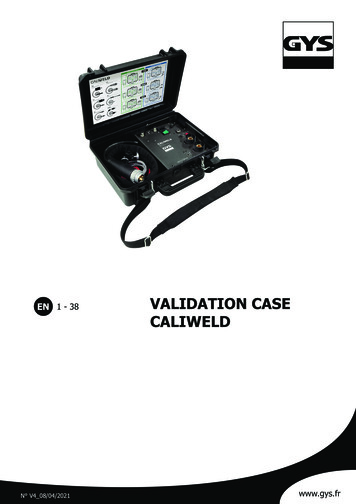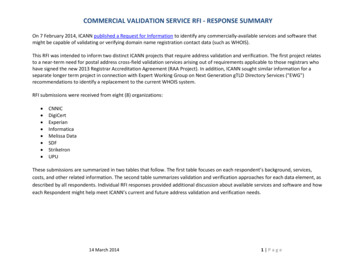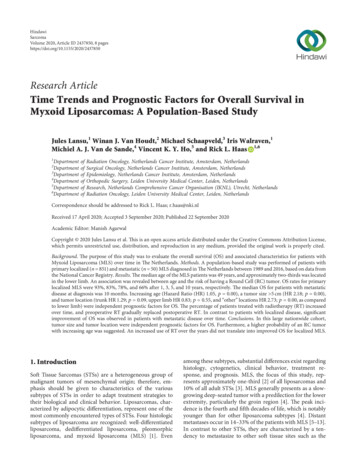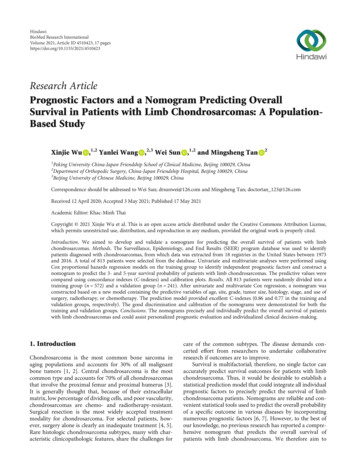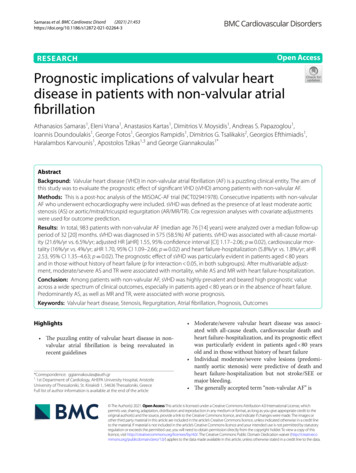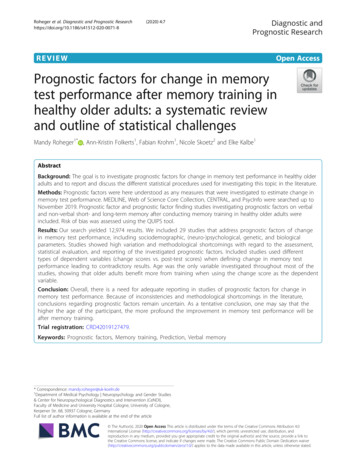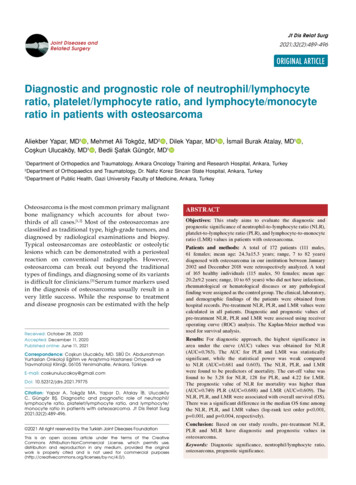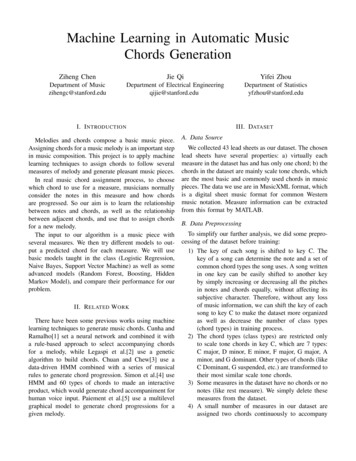
Transcription
Snell et al. BMC Medicine(2020) SEARCH ARTICLEOpen AccessExternal validation of prognostic modelspredicting pre-eclampsia: individualparticipant data meta-analysisKym I. E. Snell1*†, John Allotey2,3†, Melanie Smuk3, Richard Hooper3, Claire Chan3, Asif Ahmed4, Lucy C. Chappell5,Peter Von Dadelszen5, Marcus Green6, Louise Kenny7, Asma Khalil8, Khalid S. Khan2,3, Ben W. Mol9, Jenny Myers10,Lucilla Poston5, Basky Thilaganathan8, Anne C. Staff11, Gordon C. S. Smith12, Wessel Ganzevoort13,Hannele Laivuori14,15,16, Anthony O. Odibo17, Javier Arenas Ramírez18, John Kingdom19, George Daskalakis20,Diane Farrar21, Ahmet A. Baschat22, Paul T. Seed5, Federico Prefumo23, Fabricio da Silva Costa24, Henk Groen25,Francois Audibert26, Jacques Masse27, Ragnhild B. Skråstad28,29, Kjell Å. Salvesen30,31, Camilla Haavaldsen32,Chie Nagata33, Alice R. Rumbold34, Seppo Heinonen35, Lisa M. Askie36, Luc J. M. Smits37, Christina A. Vinter38,Per Magnus39, Kajantie Eero40,41, Pia M. Villa35, Anne K. Jenum42, Louise B. Andersen43,44, Jane E. Norman45,Akihide Ohkuchi46, Anne Eskild32,47, Sohinee Bhattacharya48, Fionnuala M. McAuliffe49, Alberto Galindo50,Ignacio Herraiz50, Lionel Carbillon51, Kerstin Klipstein-Grobusch52, Seon Ae Yeo53, Joyce L. Browne52,Karel G. M. Moons52,54, Richard D. Riley1, Shakila Thangaratinam55 and for the IPPIC Collaborative NetworkAbstractBackground: Pre-eclampsia is a leading cause of maternal and perinatal mortality and morbidity. Early identification ofwomen at risk during pregnancy is required to plan management. Although there are many published predictionmodels for pre-eclampsia, few have been validated in external data. Our objective was to externally validate publishedprediction models for pre-eclampsia using individual participant data (IPD) from UK studies, to evaluate whether any ofthe models can accurately predict the condition when used within the UK healthcare setting.Methods: IPD from 11 UK cohort studies (217,415 pregnant women) within the International Prediction of PregnancyComplications (IPPIC) pre-eclampsia network contributed to external validation of published prediction models,identified by systematic review. Cohorts that measured all predictor variables in at least one of the identified modelsand reported pre-eclampsia as an outcome were included for validation. We reported the model predictiveperformance as discrimination (C-statistic), calibration (calibration plots, calibration slope, calibration-in-the-large), andnet benefit. Performance measures were estimated separately in each available study and then, where possible,combined across studies in a random-effects meta-analysis.(Continued on next page)* Correspondence: k.snell@keele.ac.uk†Kym IE Snell and John Allotey are joint first authors (both contributedequally).1Centre for Prognosis Research, School of Primary, Community and SocialCare, Keele University, Keele, UKFull list of author information is available at the end of the article The Author(s). 2020 Open Access This article is licensed under a Creative Commons Attribution 4.0 International License,which permits use, sharing, adaptation, distribution and reproduction in any medium or format, as long as you giveappropriate credit to the original author(s) and the source, provide a link to the Creative Commons licence, and indicate ifchanges were made. The images or other third party material in this article are included in the article's Creative Commonslicence, unless indicated otherwise in a credit line to the material. If material is not included in the article's Creative Commonslicence and your intended use is not permitted by statutory regulation or exceeds the permitted use, you will need to obtainpermission directly from the copyright holder. To view a copy of this licence, visit http://creativecommons.org/licenses/by/4.0/.The Creative Commons Public Domain Dedication waiver ) applies to thedata made available in this article, unless otherwise stated in a credit line to the data.
Snell et al. BMC Medicine(2020) 18:302Page 2 of 18(Continued from previous page)Results: Of 131 published models, 67 provided the full model equation and 24 could be validated in 11 UK cohorts.Most of the models showed modest discrimination with summary C-statistics between 0.6 and 0.7. The calibration ofthe predicted compared to observed risk was generally poor for most models with observed calibration slopes lessthan 1, indicating that predictions were generally too extreme, although confidence intervals were wide. There waslarge between-study heterogeneity in each model’s calibration-in-the-large, suggesting poor calibration of thepredicted overall risk across populations. In a subset of models, the net benefit of using the models to inform clinicaldecisions appeared small and limited to probability thresholds between 5 and 7%.Conclusions: The evaluated models had modest predictive performance, with key limitations such as poor calibration(likely due to overfitting in the original development datasets), substantial heterogeneity, and small net benefit acrosssettings. The evidence to support the use of these prediction models for pre-eclampsia in clinical decision-making islimited. Any models that we could not validate should be examined in terms of their predictive performance, netbenefit, and heterogeneity across multiple UK settings before consideration for use in practice.Trial registration: PROSPERO ID: CRD42015029349.Keywords: Pre-eclampsia, External validation, Prediction model, Individual participant dataBackgroundPre-eclampsia, a pregnancy-specific condition withhypertension and multi-organ dysfunction, is a leadingcontributor to maternal and offspring mortality andmorbidity. Early identification of women at risk ofpre-eclampsia is key to planning effective antenatalcare, including closer monitoring or commencementof prophylactic aspirin in early pregnancy to reducethe risk of developing pre-eclampsia and associatedadverse outcomes. Accurate prediction of preeclampsia continues to be a clinical and research priority [1, 2]. To-date, over 120 systematic reviews havebeen published on the accuracy of various tests topredict pre-eclampsia; more than 100 predictionmodels have been developed using various combinations of clinical, biochemical, and ultrasound predictors [3–6]. However, no single prediction model isrecommended by guidelines to predict pre-eclampsia.Risk stratification continues to be based on the presence or absence of individual clinical markers, andnot by multivariable risk prediction models.Any recommendation to use a prediction model inclinical practice must be underpinned by robust evidence on the reproducibility of the models, their predictive performance across various settings, and theirclinical utility. An individual participant data (IPD)meta-analysis that combines multiple datasets has greatpotential to externally validate existing models [7–10].In addition to increasing the sample size beyond what isfeasibly achievable in a single study, access to IPD frommultiple studies offers the unique opportunity to evaluate the generalisability of the predictive performance ofexisting models across a range of clinical settings. Thisapproach is particularly advantageous for predicting therare but serious condition of early-onset pre-eclampsiathat affects 0.5% of all pregnancies [11].We undertook an IPD meta-analysis to externally validate the predictive performance of existing multivariable models to predict the risk of pre-eclampsia inpregnant women managed within the National HealthService (NHS) in the UK and assessed the clinical utilityof the models using decision curve analysis.MethodsInternational Prediction of Pregnancy Complications (IPPIC)NetworkWe undertook a systematic review of reviews by searching Medline, Embase, and the Cochrane Library including DARE (Database of Abstracts of Reviews of Effects)databases, from database inception to March 2017, toidentify relevant systematic reviews on clinical characteristics, biochemical, and ultrasound markers for predicting pre-eclampsia [12]. We then identified researchgroups that had undertaken studies reported in the systematic reviews and invited the authors of relevant studies and cohorts with data on prediction of pre-eclampsiato share their IPD [13] and join the IPPIC (InternationalPrediction of Pregnancy Complications) CollaborativeNetwork. We also searched major databases and data repositories, and directly contacted researchers to identifyrelevant studies, or datasets that may have been missed,including unpublished research and birth cohorts. TheNetwork includes 125 collaborators from 25 countries, issupported by the World Health Organization, and hasover 5 million IPD containing information on variousmaternal and offspring complications. Details of thesearch strategy are given elsewhere [12].Selection of prediction models for external validationWe updated our previous literature search of predictionmodels for pre-eclampsia [3] (July 2012–December2017), by searching Medline via PubMed. Details of the
Snell et al. BMC Medicine(2020) 18:302search strategy and study selection are given elsewhere(Supplementary Table S1, Additional file 1) [12]. Weevaluated all prediction models with clinical, biochemical, and ultrasound predictors at various gestationalages (Supplementary Table S2, Additional file 1) for predicting any, early (delivery 34 weeks), and late (delivery 34 weeks’ gestation) onset pre-eclampsia. We did notvalidate prediction models if they did not provide thefull model equation (including the intercept and predictor effects), if any predictor in the model was notmeasured in the validation cohorts, or if the outcomespredicted by the model were not relevant.Page 3 of 18the quality of the collected data, as we performed theprediction model analyses ourselves since we had accessto the IPD. We classified the risk of bias to be low, high,or unclear for each of the relevant domains. Each domain included signalling questions that are rated as ‘yes’,‘probably yes’, ‘probably no’, ‘no’, or ‘no information’.Any signalling question that was rated as ‘probably no’or ‘no’ was considered to have potential for bias and wasclassed as high risk of bias in that domain. The overallrisk of bias of an IPD dataset was considered to be low ifit scored low in all domains, high if any one domain hada high risk of bias, and unclear for any otherclassifications.Inclusion criteria for IPPIC validation cohortsWe externally validated the models in IPPIC IPD cohorts that contained participants from the UK (IPPICUK subset) to determine their performance within thecontext of the UK healthcare system and to reduce theheterogeneity in the outcome definitions [14, 15]. We included UK participant whole datasets and UK participant subsets of international datasets (where countrywas recorded). If a dataset contained IPD from multiplestudies, we checked the identity of each study to avoidduplication. We excluded cohorts if one or more of thepredictors (i.e. those variables included in the model’sequation) were not measured or if there was no variationin the values of model predictors across individuals (i.e.every individual had the same predicted probability dueto strict eligibility criteria in the studies). We also excluded cohorts where no individuals or only one individual developed pre-eclampsia. Since the published modelswere intended to predict the risk of pre-eclampsia inwomen with singleton pregnancies only, we excludedwomen with multi-foetal pregnancies.IPD collection and harmonisationWe obtained data from cohorts in prospective and retrospective observational studies (including cohorts nestedwithin randomised trials, birth cohorts, and registrybased cohorts). Collaborators sent their pseudoanonymised IPD in the most convenient format forthem, and we then formatted, harmonised, and cleanedthe data. Full details on the eligibility criteria, selectionof the studies and datasets, and data preparation havepreviously been reported in our published protocol [13].Quality assessment of the datasetsTwo independent reviewers assessed the quality of eachIPD cohort using a modified version of the PROBAST(Prediction study Risk of Bias Assessment) tool [16]. Thetool assesses the quality of the cohort datasets and individual studies, and we used three of the four domains:participant selection, predictors, and outcomes. Thefourth domain ‘analysis’ was not relevant for assessingStatistical analysisWe summarised the total number of participants andnumber of events in each dataset, and the overall numbers available for validating each model.Missing dataWe could validate the predictive performance of a modelonly when the values of all its predictors were availablefor participants in at least one IPD dataset, i.e. in datasets where none of the predictors was systematicallymissing (unavailable for all participants). In such datasets, when data were missing for predictors and outcomes in some participants (‘partially missing data’), weused a 3-stage approach. First, where possible, we filledin the actual value that was missing using knowledge ofthe study’s eligibility criteria or by using other availabledata in the same dataset. For example, replacing nulliparous 1 for all individuals in a dataset if only nulliparous women were eligible for inclusion. Secondly,after preliminary comparison of other datasets with theinformation, we used second trimester information inplace of missing first trimester information. For example,early second trimester values of body mass index (BMI)or mean arterial pressure (MAP) were used if the firsttrimester values were missing. Where required, we reclassified into categories. Women of either AfroCaribbean or African-American origin were classified asBlack, and those of Indian or Pakistani origin as Asian.Thirdly, for any remaining missing values, we imputedall partially missing predictor and outcome values usingmultiple imputation by chained equations (MICE) [17,18]. After preliminary checks comparing baseline characteristics in individuals with and without missing valuesfor each variable, data were assumed to be missing atrandom (i.e. missingness conditional on other observedvariables).We conducted the imputations in each IPD datasetseparately. This approach acknowledges the clustering ofindividuals within a dataset and retains potential heterogeneity across datasets. We generated 100 imputed
Snell et al. BMC Medicine(2020) 18:302datasets for each IPD dataset with any missing predictoror outcome values. In the multiple imputation models,continuous variables with missing values were imputedusing linear regression (or predictive mean matching ifskewed), binary variables were imputed using logistic regression, and categorical variables were imputed usingmultinomial logistic regression. Complete predictorswere also included in the imputation models as auxiliaryvariables. To retain congeniality between the imputationmodels and predictive models [19], the scale used to impute the continuous predictors was chosen to match theprediction models. For example, pregnancy-associatedplasma protein A (PAPP-A) was modelled on the logscale in many models and was therefore imputed as log(PAPP-A). We undertook imputation checks by lookingat histograms, summary statistics, and tables of valuesacross imputations, as well as by checking the trace plotsfor convergence issues.Evaluating predictive performance of modelsFor each model that we could validate, we applied themodel equation to each individual i in each (imputed)dataset. For each prediction model, we summarised theoverall distribution of the linear predictor values foreach dataset using the median, interquartile range, andfull range, averaging statistics across imputations wherenecessary [20].We examined the predictive performance of eachmodel separately, using measures of discrimination andcalibration, firstly in the IPD for each available datasetand then at the meta-analysis level. We assessed modeldiscrimination using the C-statistic with a value of 1 indicating perfect discrimination and 0.5 indicating no discrimination beyond chance [21]. Good values of the Cstatistic are hard to define, but we generally consideredC-statistic values of 0.6 to 0.75 as moderate discrimination [22]. Calibration was assessed using the calibrationslope (ideal value 1, slope 1 indicates overfitting,where predictions are too extreme) and the calibrationin-the-large (ideal value 0). For each dataset containingover 100 outcome events, we also produced calibrationplots to visually compare observed and predicted probabilities when there were enough events to categoriseparticipants into 10 risk groups. These plots also included a lowess smoothed calibration curve over allindividuals.Where data had been imputed in a particular IPDdataset, the predictive performance measures were calculated in each of the imputed datasets, and thenRubin’s rules were applied to combine statistics (andcorresponding standard errors) across imputations [20,23, 24].When it was possible to validate a model in multiplecohorts, we summarised the performance measuresPage 4 of 18across cohorts using a random-effects meta-analysis estimated using restricted maximum likelihood (for eachperformance measure separately) [25, 26]. Summary(average) performance statistics were reported with 95%confidence intervals (derived using the Hartung-KnappSidik-Jonkman approach as recommended) [27, 28]. Wealso reported the estimate of between-study heterogeneity (τ2) and the proportion of variability due tobetween-study heterogeneity (I2). Where there were fiveor more cohorts in the meta-analysis, we also reportedthe approximate 95% prediction interval (using the t-distribution to account for uncertainty in τ) [29]. We onlyreported the model performance in individual cohorts ifthe total number of events was over 100. We also compared the performance of the models in the same validation cohort where possible. We used forest plots toshow a model’s performance in multiple datasets and tocompare the average performance (across datasets) ofmultiple models.A particular challenge is to predict pre-eclampsia innulliparous women as they have no history from priorpregnancies (which are strong predictors); therefore, wealso conducted a subgroup analysis in which we assessedthe performance of the models in only nulliparouswomen from each study.Decision curve analysisFor each pre-eclampsia outcome (any, early, or late onset), we compared prediction models using decisioncurve analysis [30, 31]. Decision curves show the netbenefit (i.e. benefit versus harm) over a range of clinically relevant threshold probabilities. The model with thegreatest net benefit for a particular threshold is considered to have the most clinical value. For this investigation, we chose the IPD that was most frequently used inthe external validation of the prediction models andwhich allowed multiple models to be compared in thesame IPD (thus enabling a direct, within-dataset comparison of the models).All statistical analyses were performed using Stata MPVersion 15. TRIPOD guidelines were followed for transparent reporting of risk prediction model validationstudies [32, 33]. Additional details on the missing datachecks, performance measures, meta-analysis, and decision curves are given in Supplementary Methods, Additional file 1 [20, 26, 34–45].ResultsOf the 131 models published on prediction of preeclampsia, only 67 reported the full model equationneeded for validation (67/131, 51%) (SupplementaryTable S3, Additional file 1). Twenty-four of these 67models (24/67, 36%) met the inclusion criteria for external validation in the IPD datasets (Table 1) [35, 46–56],
Snell et al. BMC Medicine(2020) 18:302Page 5 of 18and the remaining models (43/67, 64%) did not meet thecriteria due to the required predictor information notbeing available in the IPD datasets (Fig. 1).[35, 47, 48, 56] was considered adequate, based on having at least 10 events per predictor evaluated to reducethe potential for model overfitting.Characteristics and quality of the validation cohortsExternal validation and meta-analysis of predictiveperformanceIPD from 11 cohorts contained within the IPPIC network contained relevant predictors and outcomes thatcould be used to validate at least one of the 24 prediction models. Four of the 11 validation cohorts were prospective observational studies (Allen 2017, POP, SCOPE,and Velauthar 2012) [36, 37, 45], four were nestedwithin randomised trials (Chappell 1999, EMPOWAR,Poston 2006, and UPBEAT) [39–42], and three werefrom prospective registry datasets (ALSPAC, AMND,and St George’s) [38, 43, 44, 57]. Six cohorts includedpregnant women with high and low risk of preeclampsia [37, 38, 43–45], four included high-riskwomen only [39–42], and one included low-risk womenonly [36]. Two of the 11 cohorts (SCOPE, POP) includedonly nulliparous women with singleton pregnancies whowere at low risk [36] and at any risk of pre-eclampsia[45]. In the other 9 cohorts, the proportion of nulliparous women ranged from 43 to 65%. Ten of the 11 cohorts reported on any-, early-, and late-onset preeclampsia, while one had no women with early-onsetpre-eclampsia [40]. The characteristics of the validationcohorts and a summary of the missing data for each predictor and outcome are provided in Supplementary Tables S4, S5, and S6 (Additional file 1), respectively.A fifth of all validation cohorts (2/11, 18%) wereclassed as having an overall low risk of bias for all threePROBAST domains of participant selection, predictorevaluation, and outcome assessment. Seven (7/11, 64%)had low risk of bias for participant selection domain,and ten (10/11, 91%) had low risk of bias for predictorassessment, while one had an unclear risk of bias for thatdomain. For outcome assessment, half of all cohorts hadlow risk of bias (5/11, 45%) and it was unclear in the rest(6/11, 55%) (Supplementary Table S7, Additional file 1).Characteristics of the validated modelsAll of the models we validated were developed in unselected populations of high- and low-risk women. Abouttwo thirds of the models (63%, 15/24) included onlyclinical characteristics as predictors [35, 46, 47, 49, 51–53, 55], five (21%) included clinical characteristics andbiomarkers [46, 48, 50, 54], and four (17%) includedclinical characteristics and ultrasound markers [50, 56].Most models predicted the risk of pre-eclampsia usingfirst trimester predictors (21/24, 88%), and three usingfirst and second trimester predictors (13%). Eight modelspredicted any-onset pre-eclampsia, nine early-onset, andseven predicted late-onset pre-eclampsia (Table 1). Thesample size of only a quarter of the models (25%, 6/24)We validated the predictive performance of each of the24 included models in at least one and up to eight validation cohorts. The distributions of the linear predictorand the predicted probability are shown for each modeland validation cohort in Supplementary Table S8 (Additional file 1). Performance of models is given for eachcohort separately (including smaller datasets) in Supplementary Table S9 (Additional file 1).Performance of models predicting any-onset pre-eclampsiaTwo clinical characteristics models (Plasencia 2007a;Poon 2008) with predictors such as ethnicity, family history of pre-eclampsia, and previous history of preeclampsia showed reasonable discrimination in validation cohorts with summary C-statistics of 0.69 (95% CI0.53 to 0.81) for both models (Table 2). The modelswere potentially overfitted (summary calibration slope 1) indicating extreme predictions compared to observedevents, with wide confidence intervals, and large heterogeneity in discrimination and calibration (Table 2). Thethird model (Wright 2015a) included additional predictors such as history of systemic lupus erythematosus,anti-phospholipid syndrome, history of in vitro fertilisation, chronic hypertension, and interval between pregnancies, and showed less discrimination (summary Cstatistic 0.62, 95% CI 0.48 to 0.75), with observed overfitting (summary calibration slope 0.64) (Table 2).The three models with clinical and biochemical predictors (Baschat 2014a; Goetzinger 2010; Odibo 2011a)showed moderate discrimination (summary C-statistics0.66 to 0.72) (Table 2). We observed underfitting (summary calibration slope 1) with predictions that do notspan a wide enough range of probabilities compared towhat was observed in the validation cohorts (Fig. 2).Amongst these three models, the Odibo 2011a modelwith ethnicity, BMI, history of hypertension, and PAPPA as predictors showed the highest discrimination (summary C-statistic 0.72, 95% CI 0.51 to 0.86), with a summary calibration slope of 1.20 (95% CI 0.24 to 2.00) dueto heterogeneity in calibration performance across thethree cohorts.When validated in individual cohorts, the Odibo 2011amodel demonstrated better discrimination in the POPcohort of any risk nulliparous women (C-statistics 0.78,95% CI 0.74 to 0.81) than in the St George’s cohort ofall pregnant women (C-statistics 0.67, 95% CI 0.65 to0.69). The calibration estimates for Odibo 2011a modelin these two cohorts showed underfitting in the POP
Snell et al. BMC Medicine(2020) 18:302Page 6 of 18Table 1 Pre-eclampsia prediction model equations externally validated in the IPPIC-UK cohortsModelno.Author(year)Predictor categoryPrediction model equation for linear predictor (LP)Trimester 1 any-onset pre-eclampsia models1Plasencia2007aClinical characteristicsLP 6.253 1.432(if Afro-Caribbean ethnicity) 1.465(if mixed ethnicity) 0.084(BMI) 0.81(ifwoman’s mother had PE) 1.539(if parous without previous PE) 1.049(if parous with previousPE)2Poon 2008Clinical characteristicsLP 6.311 1.299(if Afro-Caribbean ethnicity) 0.092(BMI) 0.855(if woman’s mother hadPE) 1.481(if parous without previous PE) 0.933(if parous with previous PE)3Wright2015a*Clinical characteristicsMean gestational age at delivery with PE 54.3637 0.0206886(age, years - 35, if age 35) 0.11711(height, cm - 164) 2.6786(if Afro-Caribbean ethnicity) 1.129(if South Asian ethnicity) 7.2897(if chronic hypertension) 3.0519(if systemic lupus erythematosus or antiphospholipidsyndrome) 1.6327(if conception by in vitro fertilisation) 8.1667(if parous with previous PE) 0.0271988(if parous with previous PE, previous gestation in weeks - 24)2 4.335(if parous withno previous PE) 4.15137651(if parous with no previous PE, interval between pregnancies inyears) 1 9.21473572(if parous with no previous PE, interval between pregnancies in years) 0.5 0.0694096(if no chronic hypertension, weight in kg – 69) 1.7154(if no chronic hypertensionand family history of PE) 3.3899(if no chronic hypertension and diabetes mellitus type 1 or 2)4Baschat2014aClinical characteristics andbiochemical markersLP 8.72 0.157 (if nulliparous) 0.341(if history of hypertension) 0.635(if prior PE) 0.064(MAP) 0.186(PAPP-A, Ln MoM)5Goetzinger2010Clinical characteristics andbiochemical markersLP 3.25 (0.51(if PAPP-A 10th percentile) 0.93(if BMI 25) 0.94(if chronic hypertension) 0.97(if diabetes) 0.61(if African American ethnicity)6Odibo2011aClinical characteristics andbiochemical markersLP 3.389 0.716(PAPP-A, MoM) 0.05(BMI) 0.319(if black ethnicity) 1.57(if history ofchronic hypertension)7Odibo2011bClinical characteristics andultrasound markersLP 3.895 0.593(mean uterine PI) 0.944(if pre-gestational diabetes) 0.059(BMI) 1.532(ifhistory of chronic hypertension)Trimester 2 any-onset pre-eclampsia models8Yu 2005aClinical characteristics andultrasound markersLP 1.8552 5.9228(mean uterine PI) 2 14.4474(mean uterine PI) 1 0.5478(if smoker) 0.6719(bilateral notch) 0.0372(age) 0.4949(if black ethnicity) 1.5033(if history of PE) 1.2217(if previous term live birth) 0.0367(T2 BMI)Trimester 1 early-onset pre-eclampsia models9Baschat2014bClinical characteristicsLP 5.803 0.302(if history of diabetes) 0.767 (if history of hypertension) 0.00948(MAP)10Crovetto2015aClinical characteristicsLP 5.177 (2.383 if black ethnicity) 1.105(if nulliparous) 3.543(if parous with previousPE) 2.229(if chronic hypertension) 2.201(if renal disease)11Kuc 2013aClinical characteristicsLP 6.790 0.119(maternal height, cm) 4.8565(maternal weight, Ln kg) 1.845(ifnulliparous) 0.086(maternal age, years) 1.353(if smoker)12Plasencia2007bClinical characteristicsLP 6.431 1.680(if Afro-Caribbean ethnicity) 1.889(if mixed ethnicity) 2.822(if parouswith previous PE)13Poon 2010aClinical characteristicsLP 5.674 1.267(if black ethnicity) 2.193(if history of chronic hypertension) 1.184(ifparous without previous PE) 1.362(if parous with previous PE) 1.537(if conceived withovulation induction)14Scazzocchio2013aClinical characteristicsLP 7.703 0.086(BMI) 1.708(if chronic hypertension) 4.033(if renal disease) 1.931(ifparous with previous PE) 0.005(if parous with no previous PE)15Wright2015b*Clinical characteristicsSame as model 316Poon 2009aClinical characteristics andbiochemical markersLP 6.413 3.612 (PAPP-A, Ln MoM) 1.803(if history of chronic hypertension) 1.564(ifblack ethnicity) 1.005(if parous without previous PE) 1.491(if parous with previous PE)Trimester 2 early-onset pre-eclampsia models17Yu 2005bClinical characteristics andultrasound markersLP 9.81223 2.10910(mean uterine PI)3 1.79921(mean uterine PI)3 1.059463(if bilateralnotch)Trimester 1 late-onset pre-eclampsia models18Crovetto2015bClinical characteristicsLP 5.873 0.462(if white ethnicity) 0.109(BMI) 0.825(if nulliparous) 2.726(if parous withprevious PE) 1.956(if chronic hypertension) 0.575(if smoker)19Kuc 2013bClinical characteristicsLP 1
of the models using decision curve analysis. Methods International Prediction of Pregnancy Complications (IPPIC) Network We undertook a systematic review of reviews by search-ing Medline, Embase, and the Cochrane Library includ-ing DARE (Database of Abstracts of Reviews of Effects) databases, from database inception to March 2017, to
